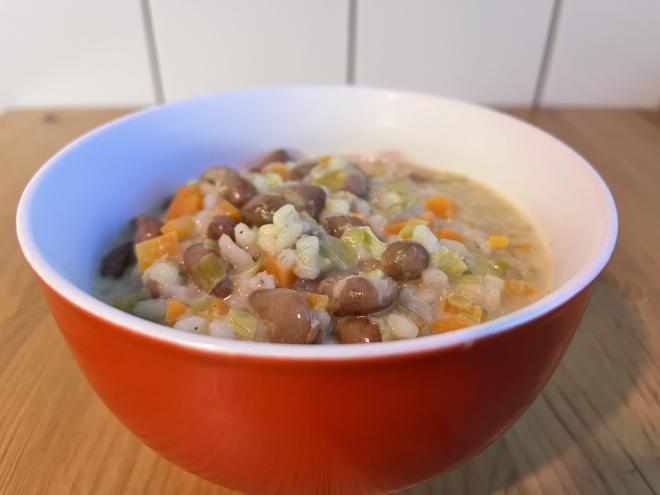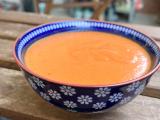- Climate-Friendly Cooking :carrot: /
- Recipes/
- Grisons Pearl Barley Soup - A Heart-Warming Vegetarian Soup from Eastern Switzerland/
Grisons Pearl Barley Soup - A Heart-Warming Vegetarian Soup from Eastern Switzerland
Table of Contents
Jump to Recipe
Jump to Carbon Footprint
Grisons pearl barley soup is a classic in Switzerland: many people associate it with memories of skiing and a hot meal afterwards. The vegetables and barley quickly warm the stomach.

There are many variations of barley soup: some use cabbage instead of beans, add potatoes, or add diced bacon or air-dried meat (e.g. Bündnerfleisch as a Swiss variant). It is very easy to adapt the soup to your own taste - for example, if you fancy something meaty, you can finely dice smoked tofu, fry it in a pan, and add it when serving.
Pearl barley absorbs a lot of water. If the soup gets too thick and looks more like a stew, you can of course add some water or vegetable stock.
This recipe is based on the one from Tibits, a vegetarian restaurant in Switzerland. If you follow a vegan diet, Tibits suggests replacing the cream with a vegan cream sauce.
Recipe #
Grisons pearl barley soup with vegetables
40 minutes
2 portions
Ingredients #
- 50 g leek
- 2 carrots
- 50 g celeriac
- 2 tablespoons oil
- 80 g pearl barley
- 300 ml vegetable stock
- 50 g cooked beans
- 100 g double cream
- 1 pinch of pepper
Directions #
- Peel the carrots and celeriac, and dice finely with the leek. Heat the oil in a frying pan and sauté the diced vegetables for 3-5 minutes.
- Add the pearl barley and sauté for another minute.
- Add the vegetable stock and 300 ml water. Bring to the boil, then cover and simmer on a low heat for about 30 minutes.
- Add the beans and cream, and season with pepper. Leave to simmer for a further 5-10 minutes - serve when the barley is tender but still has some bite.
Carbon Footprint #
In total, two portions of Grisons pearl barley soup with vegetables have an estimated carbon footprint of 1085 g.
This ranks it number 16 out of 57 recipes published on the blog so far in terms of estimated carbon footprint.
It is therefore part of the best tertile (top 33%) of the recipes with the lowest emission impact. 🤗When it comes to ingredients, cream stands out: although it makes up only about 10% of the soup, it accounts for almost 40% of the recipe’s greenhouse gas emissions. This is, of course, due to the very CO2-intensive dairy industry and the methane emissions from the cows during their lifetime. If you replaced the dairy cream in the recipe with oat cream, you could reduce the carbon footprint by an estimated 360 g. The recipe already has a pretty good carbon footprint compared to other recipes published here on the blog, but this change would put it in the top group for good.
As for the other ingredients, it is interesting to note that although carrots, leeks, celery, and pearl barley are the main ingredients of the soup, together they account for less than a tenth of the estimated carbon footprint of the Grisons barley soup.
| ingredient | carbon footprint per kg | carbon footprint (in g) for 2 servings | % of ingredients | % of CO2 emissions |
|---|---|---|---|---|
| Leek | 0.2 | 10 | 6% | 1% |
| Carrots | 0.1 | 16 | 20% | 1% |
| Celeriac | 0.2 | 10 | 6% | 1% |
| Oil | 3.2 | 32 | 1% | 3% |
| Pearl barley | 0.6 | 48 | 10% | 4% |
| Vegetable stock | 1.4 | 408 | 37% | 38% |
| Beans | 1.3 | 65 | 6% | 6% |
| Double cream | 4.2 | 420 | 12% | 39% |
| Pepper | 1.1 | 2 | 0% | 0% |
| Cooking | 74 | 7% |


